Eliminating the Unknown
The town of Being is located somewhere in the middle of Kansas. (note: fictional stories are frequently set in places “far, far away.” However, since most High School graduates cannot find Kansas on a map, it serves the same purpose. Unless, of course, you happen to be from Kansas, in which case the first line should read, “The town of Being is located somewhere in the middle of Vermont. I don’t think we’re in Kansas anymore.)”
Within the town things don’t work as smoothly as they should, because the people don’t work as smoothly as they should. The problem is not that they don’t work, but that they don’t work together. You see, everyone has a job to do, and everyone performs his or her job fairly well. However, as far as the days’ activities go, each being in Being is concerned only with his or her own task. Except when forced to mix or speak to someone else outside of their immediate group, they don’t. It could be said that they all live within their own bubbles. Unless two people shared the same interest, the beings in Being see very little reason to communicate outside of their sphere–they see no point in bursting their own bubble.
In town there is a sum of mathematicians who are only interested in numbers and believe only in things that can be proven using mathematical formula. They are very left brained. They consider themselves the most logical and level headed of all the Being specializations; they believed all non-mathematical activities are full of too many uncertainties, and therefore just play. As you can imagine, they lead a fairly routine life.
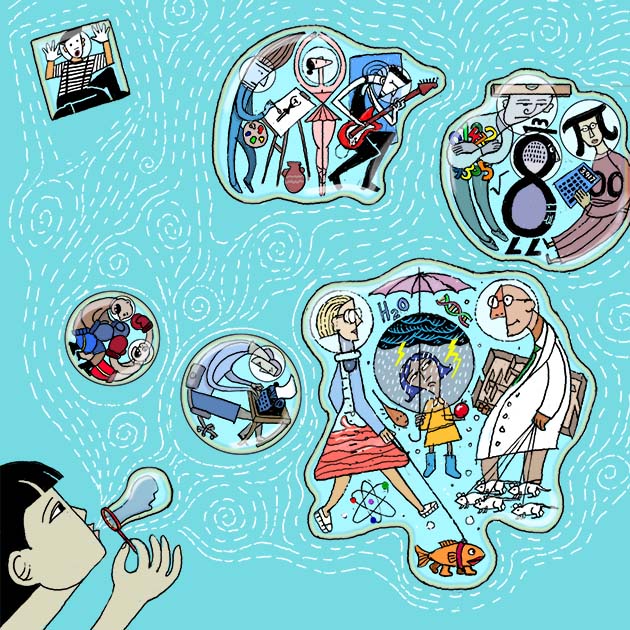
There is a cluster of scientists who form a very homogenous group and talked to each other, but only about what they have in common. These scientists are always talking about the earth and planets, why things are the way they are, what experiments they are conducting and what they are suppose to prove or disprove. The larger group of scientists are subdivided into smaller groups with specialized interest. Some are only interested in plants, some only interested in animals, some only in weather, and so on. The one thing that all members of this group believed is that climate change is real. They get very frustrated with those that doubt the science behind their research, and love to quote Neil deGrasse Tyson, “The good thing about Science is that it’s true whether or not you believe in it.” Similar to mathematicians, scientist are very left brained. The scientists believed that the left side of the human brain controlles reason and logic, while the right side controles imaginations and creativity. And since logic and reason should most certainly take precedence over imagination and creativity they very rarely used the right side of their brain. As it was written in the Journal of Being Scientists, “experimentation should follow a step-by-step logical progression: Step A, should be followed by Step B, which should be followed by Step C. To skip from A to C was ludicrous and risky.”
A team affectionately calling themselves “Jocks”, are only interested in physical fitness and sport. They think the point of all activity should be to win: to pit yourself or your team up against someone else or someone elses team is all that held their interest. Their social activities center on pre-game strategies, post-game analysis, and of course -- the games themselves.
There is also a spectrum of artist whose total focus is centered around culture. To pursue artistic endeavors, they feel, is the height of human activity. Painters, sculptures, dancers, designers, actors, musicians and the like-minded acknowledged their common interest, but still spent most of their time in their individual subgroups. So complex are these groups that even the subgroups are divided into smaller sub-subgroups. Among the painters, the abstractionists refused to acknowledge the representationalist. Among the musicians, the classical musicians rarely acknowledged the folk or rock group; and within the rock group the punk group rarely mixed with the heavy medallist.
The writers are divided into two major groups: those that write fiction and those that write non-fiction, the later include journalist. Although towards the beginning of the 21st century, in their quest to capture headlines, journalist had a hard time separating fact from fiction. Writers write and write reviews about what the other writers write. They have the responsibility for recording history and producing the local newspaper. However, artist only read cultrual section, the Jock only read the sports pages, and so on.
A few splinter groups like the poets formed to bridge the artist group with the writers, but no one really understands poetry, so no one much, except poets ever read it. And that’s the way things are in Being.
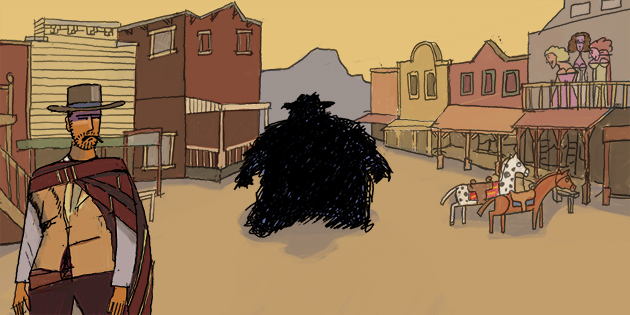
Until one day a strange being, not a human being, rolled into Being like Clint Eastwood in a spaghetti western and plopped itself down in the middle of town. It is, for lack of a better description, “pretty nondescript”. As the Being News described it, “The unknown thing looks like a big dark blob”. The scientist said its order, family, genius and species are unknown because it isn’t a thing at all. They tried to explain that what people saw was nothing -- a void, its shape was defined by its’ surroundings. It was a kind of black whole that came to reside in the center of town. As they went on to expain, "Imagine a large map of the town; now rip a whole in the middle of the map; what you would have in the center is nothing." The mathematicians estimated it size as 1.2m x 1.2m. (A measurement which most of the citizen found useless because, with the exception of mathematicians and scientist, no one bothered to learn the metric system). The scientist tried to analysize it’s genetic composition, but found this impossible as there was (so to speak) nothing there, and the Jocks wanted to challenge it to a boxing match. This, the scientist said would be like putting your fist through the whole in the center of a large map of the town, and of course, a pointless activity – mic drop.
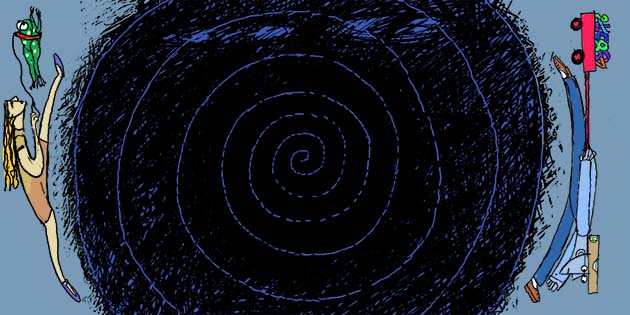
The problems they were all trying to solve were: what is it, why is it there, what does it want, and what are the citizens of Being going to do about it? And so, they did what most human beings do when they don’t understand something–they do nothing, and tried to forget about it. It’s not that they didn’t know that this thing occupied space in the center of town, it’s that they lost interest in it. Although they would soon find out that ignoring something doen’t make it go away–like weeds in a garden, or a collage loan debt, they continue to grow – as did the unknown thing in the middle of town. Ignoring things, of course, leads to ignorance, which leads to the fear of things we don’t uderstand. They avoided the Unknown, and chose to simply walk around it rather then face up to what they don’t understand. This seemed a sensible thing to do until they noticed that the path to get around it was getting longer and longer. The Unknown is growing and growing! What was once a “couriosity ignored” became a real “kick in the keister”.
While working to solve the above stated problems, things got stranger. While the town’s people tried to ignore a black whole in the middle of town because it was something that isn’t really there, they had a harder time ignoring the fact that things that were once there were no longer there. Things that once occupied space seemed to be disappearing. Things were, as the phrase goes, found missing. (“Found missing” is, of course, an oxymoron because you can’t find something if it’s missing. Like the black whole in the center of town; you can only see it because nothing else is there. Get it? )
 It was McKinley Morganfield who first found something missing. McKinley was a scavenger. He never recycled anything. He saved empty peanut butter jar and
small scraps of wood. He was sure that oneday he’d find a use for each and everything.
You can imagine what his attic looked liked. Sometime during the first month after the
arrival of the Unknown, McKinley was looking for a place to store a box of old Cracker
Jack toys he was sure would be collectors items one day, when he noticed that his
attic, which was over full a few weeks back, was instead -- empty. Not a “black whole”
type of empty, but a “there’s nothing there” type of empty. Storming into the police station
he demanded that the sheriff form a posse and get to the bottom of the case. (McKinley
was a big fan of Western movies so he used the term “posse” rather than just asking the
police chief to get on it.), which the police chief did (get on it, not form a posse). Two days
later they got their first break in the case – sort of. The junk that had been piling up behind
B.B. Grunt’s back fence disappeared. Then Jamesetta Hawkins’ treadmill disappeared, and
a fondue pot that Maggie May received as a wedding present some twenty years earlier, but
had never used, disappeared. As the chief point out, “the thing linking the thefts is that the
stuff that was disappearing was stuff nobody really used.” McKinley Morganfield collected
stuff that he thought he might use one day, but never did. He collected things he felt one
day would become collectors’ items, but had no intention of ever selling them. Jamesetta
bought the treadmill with good intentions, but after a few weeks, it just collected dust. Mrs.
May didn’t like fondue. Mr. Grunt was actually happy to get rid of his junk—it was just junk.
It was McKinley Morganfield who first found something missing. McKinley was a scavenger. He never recycled anything. He saved empty peanut butter jar and
small scraps of wood. He was sure that oneday he’d find a use for each and everything.
You can imagine what his attic looked liked. Sometime during the first month after the
arrival of the Unknown, McKinley was looking for a place to store a box of old Cracker
Jack toys he was sure would be collectors items one day, when he noticed that his
attic, which was over full a few weeks back, was instead -- empty. Not a “black whole”
type of empty, but a “there’s nothing there” type of empty. Storming into the police station
he demanded that the sheriff form a posse and get to the bottom of the case. (McKinley
was a big fan of Western movies so he used the term “posse” rather than just asking the
police chief to get on it.), which the police chief did (get on it, not form a posse). Two days
later they got their first break in the case – sort of. The junk that had been piling up behind
B.B. Grunt’s back fence disappeared. Then Jamesetta Hawkins’ treadmill disappeared, and
a fondue pot that Maggie May received as a wedding present some twenty years earlier, but
had never used, disappeared. As the chief point out, “the thing linking the thefts is that the
stuff that was disappearing was stuff nobody really used.” McKinley Morganfield collected
stuff that he thought he might use one day, but never did. He collected things he felt one
day would become collectors’ items, but had no intention of ever selling them. Jamesetta
bought the treadmill with good intentions, but after a few weeks, it just collected dust. Mrs.
May didn’t like fondue. Mr. Grunt was actually happy to get rid of his junk—it was just junk.
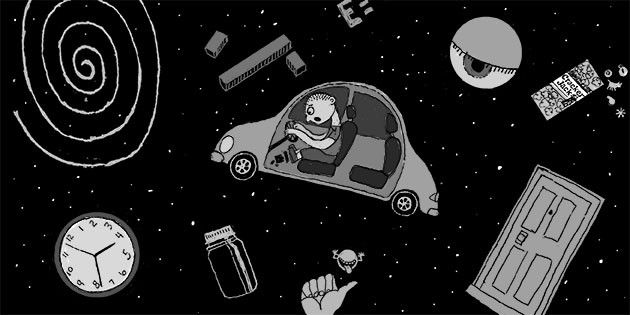
Then things got stranger still. Real strange, like “The Twilight Zone” strange (do-do-dodo). Riley King first notice that something was happening when he sat behind the wheel of his car and his feet could not reach the pedals. He loved his car, loved driving it so much that he never walked anywhere. When he’d go to the mall he’d drive around the parking lot several times until he found a spot as close to the entrance as possible. He didn’t want to walk very far. He would even drive down to the end of his driveway to pick up his mail. So at first, the shorting of his legs only seemed a minor inconvenience. He thought he could just scoot down in the seat, drive over to McKinley’s, who was bound to have a few block of wood that he could duct tape to the pedals and be off again. But McKinley’s blocks of wood were all gone.
And as it turned out, this was just the tip of the iceberg. (Of course there are no icebergs in Kansas, so the iceberg reference here is to the Titanic before it crashed and sank. The use of the phrase, “tip of the iceberg” is used as a metaphor to let the reader know that the town is about to crash and sink).
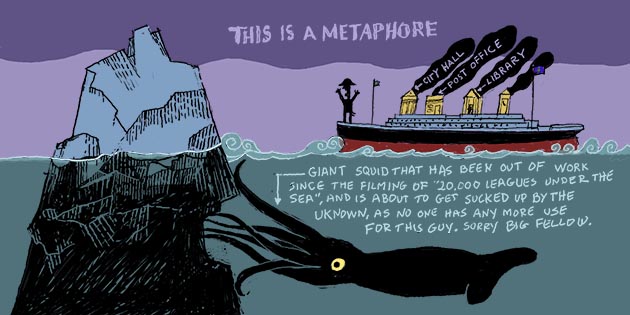
People who once enjoyed writing formal letters, but in the past few years had opted to communicate with no more than 120 characters, using emojis, acronyms and abbreviations had lost the ability to write longhand. Maggie May wanted to write a short note to her husband that she was going out to find her fondue pot that was found missing (another use of that oximoron), but couldn’t find a blank piece of paper or a pen, and so decided to just send a note in messanger,
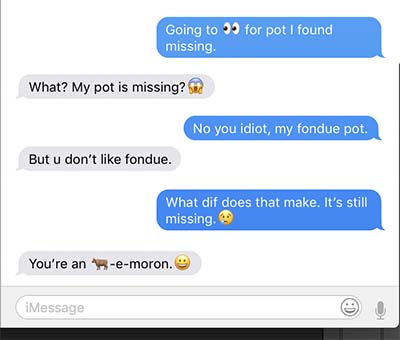
Then “POOOF!” the post office disappeared, followed by the disappearance of the public library.
All this time the Unknown is getting biger and biger along with everyone’s state of panic.
And the Beings in Being did what everyone does when they have questions about what to
do, they turned to Google. 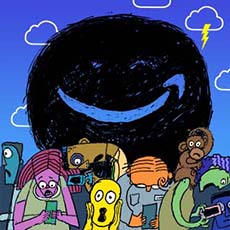 With the drastic increase in internet traffic, what happened was worse then the town crashing and sinking – the internet did! Without the internet, Beings
became disoriented. They seemed to have lost their ability to get from point A to point B
without the assistance of navagational apps. In addition to loosing their ability to write
in complete sentences, they lost the ability to do simple math problems – a result of
their complete reliance on hand held electroic calculators. With the exception of a microwaveable meals they lost their abiity to cook. If they had managed to login to Google—Google would have
directed them to Amazon.com to buy replacements for the things they found missing and a whole lot of duct tape to hold down any additional things for disapearing.
(“If you can’t keep things from disappearing with duct tape, you’re not using enough duct tape.”)
With the drastic increase in internet traffic, what happened was worse then the town crashing and sinking – the internet did! Without the internet, Beings
became disoriented. They seemed to have lost their ability to get from point A to point B
without the assistance of navagational apps. In addition to loosing their ability to write
in complete sentences, they lost the ability to do simple math problems – a result of
their complete reliance on hand held electroic calculators. With the exception of a microwaveable meals they lost their abiity to cook. If they had managed to login to Google—Google would have
directed them to Amazon.com to buy replacements for the things they found missing and a whole lot of duct tape to hold down any additional things for disapearing.
(“If you can’t keep things from disappearing with duct tape, you’re not using enough duct tape.”)
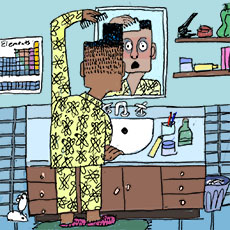 But the weirdest abnormality was noticed one morning when Vicent Furnier, the
preeminent scientist of the town, noticed when combing his hair, that it was sticking
out funny on the right side of his head. A similar thing happened to D.O. Shamp
-- only his hair problem was on the left side.
But the weirdest abnormality was noticed one morning when Vicent Furnier, the
preeminent scientist of the town, noticed when combing his hair, that it was sticking
out funny on the right side of his head. A similar thing happened to D.O. Shamp
-- only his hair problem was on the left side.
Shamp was the only artist in town to have had an exhibition in New York – a true Advent Garde artist who preferred to talk about concepts rather then produce anything concrete. His exhibition titled “Line” consisted of a white room with a single black line running around it circumference. This, he claimed, represented a dot in continuous motion. He was working on his next big statement “Nothing”. The exhibition would consist of an empty gallery. He was going to take art to its logical conclusion. Viewers would enter a completely empty, dark space and would be expected to imagine the works of art that isn’t there. He was sure the New York critics would love it. Although when he explained the idea to the art critic of The Being News, the critic thought it pointless. This did not seem to bother Shump who held little respect for critics or the general public, “what do any of them know about art, let them be content with their paintings of the prairies.” To which Ernest Evans, leader of the prairie painters movement retorted, “if Shump was so interested in creating the impression of nothingness, he need to look no futher than the unknown thing occupying space in the center of town. In response, Shump declaired “The Unknown” a “Ready Made”, and proceeded to figure out how to move it to New York.
Anyway, to get back to the story and the problem of hair, it appeared that the right side of Reginald’s head, and the left side of Shump’s head, “we’re shrinking”.
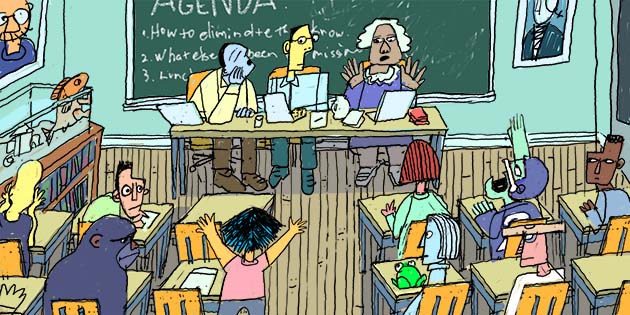
And so the debate on what to do about the Unknown continued. At the beginning of a PTA meeting whose agenda was suppose to be about curriculum, Mrs. Hawkins, the school libraian, announced that some of the books were found missing (oxymoron again). Among the books were: Huckleberry Finn, Cather in the Rye, In the Night Kitchen, Harriet The Spy, Anamal Farm, and To Kill a Mockingbird. The common thread among the books that were “found missing”, is that they are all banned books, and although the library kept copies, as they were all considered pieces of classic literatrue, no one was allow to check them out.
Then, when shock turned from disorder to mayhem, little Margaret Irene, an outspoken 14
year old, spoke up. “Don’t you see what’s happening?” she cried. “The Unknown is sucking
up everything we don’t use. It started with the junk you all collected, and once that
was gone it moved onto the physical and mental powers we are not using.” Margaret loved
reading, math, science, art, and enjoyed playing sports. 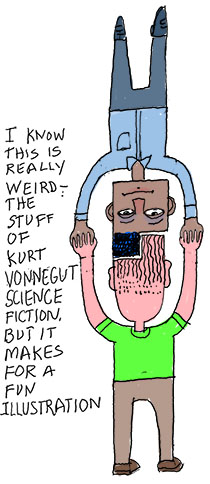 She was not the smartest in her
class or among the best athletes, but she enjoyed school, studied, did
her homework and ran or jumped rope everyday. She was simply–
above average, with a couricity she got from her love of science, an
imagination she expressed through her love of art, reason she obtained
from mathamatice, the ability to articulate her views which grew
out of her love of reading and writing, and a willingness to challenge
herself resulting from her love of sports. And she went on to explain,
“If we want to best the Unknown, we’re going to need to work toghter.”
Mr. Furnier with his half a brain felt this was perfectly logical. Then Ms.
Grace Wing, the math teacher, spoke up to say that, “we need to put
our heads together and find a solution. Science and Art go hand in
hand; equally important are math, literature, and physical education.
We need to use the logic of science, the imagination of the arts and
the physical abilities of the jocks. Mr. Furnier you need to put your left
brain next to Mr. Shump right brain,” which they did.
She was not the smartest in her
class or among the best athletes, but she enjoyed school, studied, did
her homework and ran or jumped rope everyday. She was simply–
above average, with a couricity she got from her love of science, an
imagination she expressed through her love of art, reason she obtained
from mathamatice, the ability to articulate her views which grew
out of her love of reading and writing, and a willingness to challenge
herself resulting from her love of sports. And she went on to explain,
“If we want to best the Unknown, we’re going to need to work toghter.”
Mr. Furnier with his half a brain felt this was perfectly logical. Then Ms.
Grace Wing, the math teacher, spoke up to say that, “we need to put
our heads together and find a solution. Science and Art go hand in
hand; equally important are math, literature, and physical education.
We need to use the logic of science, the imagination of the arts and
the physical abilities of the jocks. Mr. Furnier you need to put your left
brain next to Mr. Shump right brain,” which they did.
Then Mrs. Hawkins when on to explain that we need is to develop STEAMER curriculum, so that our young people cultivate a well-rounded education, and grow up to appreciate every Being’s contribution to Being as a whole.
“You mean like a large pot you use for cooking and canning? I’d love to learn how to cook. Or a big boat that is powered by a steam engine”, asked Mrs. May.
“No”, replied Jamsetta, unlike the specifics of the STEM curriculum, a “S.T.E.A.M.E.R. curriculum is inclusive rather than exclusive and embrasses Science, Technology, Engineering, Math as well as Art, Exercise and Reading. If you can read, you read you can cook Mrs. May, and why would we need a large ship powered by boiling water – we’re located in the middle of Kansas”
They then formed groups with representatives from the various specialities to study the problem. And the Beings in Being became more open minded. Riley King began a daily exercise program. Musicians studied the math behind composition, and mathamaticians learned to appreciate ABA music theory. Artist learned the science behind light and color. Everyone leaned to cook, understood the beauty of poetry and the importance of the slogan “Stong body, strong mind”. What no one seemed to notice was that as the scientist, writers, mathamticians, artist and jocks worked together to address the problem of the unkown, the Unknown began to disappear. And one day it was just gone.
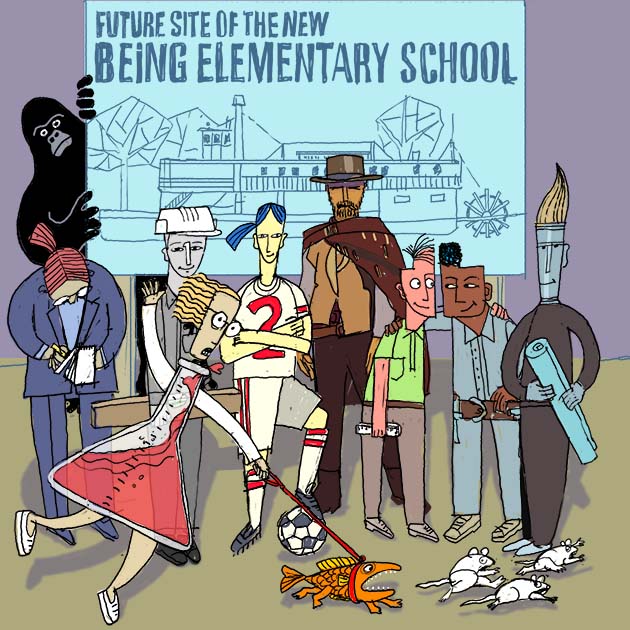
Robert Meganck